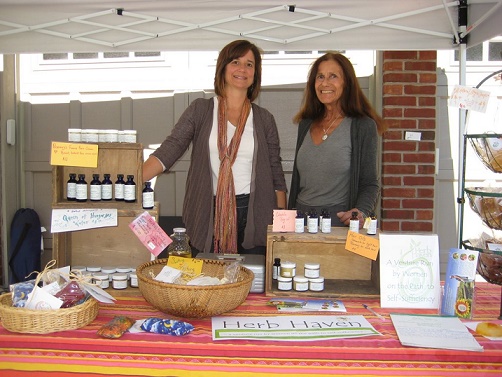Vegetation is more than a material resource for the human race. Besides being food, shelter, medicine, and raw material for numerous article of daily use, planting activity also serves as therapy for a number of physical and psychological disabilities and disorders. The ancient practice of gardening is now finding therapeutic value with horticultural therapy getting known as a non-invasive, fairly inexpensive method of natural method of treating various physical and mental health conditions. I spoke to Deborah Denome, Director of Seeking Common Ground, Inc. in Canandaigua, which is nestled in the beautiful Finger Lakes Region of Western NY, about horticultural therapy and its role in healing.
Michell: Deborah, please tell us briefly what is meant by horticultural therapy?
Deborah: Horticultural Therapy as defined by the American Horticultural Therapy Association is “the practice of horticulture as therapy to improve human well-being”. The therapeutic aspects of gardening have been intuitively known since ancient times. There are countless examples across many cultures. A historical quote (which is unknown in origin) states, “The idea started when poor people in the 1600’s worked in gardens to pay for their hospitalization. Doctors noticed these patients recovered quicker and to a better health standard than the other patients did”. In addition, the therapeutic influence of plants dates back to ancient Egypt when physicians prescribed walks in the garden for their patients. But I think clearly that working with plants was experienced as therapeutic on many levels (physical, psychological, emotional, and spiritual, etc.) way before the 1600’s. Think about the Native Americans’ (and many other indigenous peoples)’ reverence for growing and wild-crafting plants and the natural world, and their use of plants in healing; those incredible Japanese gardens that were clearly designed for their beautiful aesthetics and healing energy; and on and on. In 1879, Friends Hospital in Philadelphia built what was thought to be the first greenhouse in the United States to be used exclusively with the mentally ill.
Modern day Horticultural Therapy (HT) in the U.S. became more recognized during the rehabilitative care of hospitalized war veterans in the 1940’s and 1950’s. HT can be, and is, practiced just about anywhere. There are definitely gardens designed specifically to accommodate people with differing physical or mental abilities. Much care can go into designing and planning for safety and accessibility to enable healing, learning, and relaxing. But HT can take place in a city park or a classroom or just about anywhere plants can be grown, in the ground, raised beds, or many types of containers. Increasing numbers of care facilities, vocational programs, and even businesses are installing and expanding gardens for therapeutic purposes. They are employing HT’s are part of educational and/or therapeutic teams including teachers, doctors, psychiatrists, psychologists, occupational therapists, nurses and more. And think about it, when someone is in the hospital what do we normally do? Send flowers or plants to cheer them up.
Michell: How did you enter into this field of work?
Deborah: In 1996, my then 6th month old daughter was diagnosed with cancer (she is fine now!) Four of my peers (all women in corporate training and education) were also dealing with life-threatening issues with children and/or elderly parents. We started meeting to envision a way to redirect our education, training, and leadership skills to something closer to heart and home, something that would allow us to integrate our families into our work lives and benefit the health of our families, the community and the Earth. In 1997, we founded Seeking Common Ground, an educational non-profit dedicated to exploring, modeling and inspiring more sustainable and restorative ways of life. Our first project was an organic community farm.
After a year of working in the farm gardens with my children, friends and family (which was highly therapeutic for us!), I had a literal dream. In the dream there were many women and children who were healing from different crises, growing herbs together, and making healing herb products, while healing them. I started talking about the dream and within a few months, in 1998, we were funded to start working with a local women’s shelter to offer herbal horticulture workshops. This work became known as ‘Herb Haven’, and expanded to working with women inmates in the county jail, and a community health center that had an outreach program for victims of domestic violence.
In 2004, I learned about the profession of Horticultural Therapy and decided to become an HT. At that time, there were no U.S. programs near my home, so I received my training through the Canadian Horticultural Therapy Association, at Homewood Health Centre in Guelph, Ontario, Canada. I became certified as a Horticultural Therapist, Registered (HTR) in 2008. Now, Herb Haven has a dedicated facility with a workshop for women and their children, and permanent gardens.
Michell: So what is the main goal of this kind of therapy?
Deborah: In my eyes, the main goal of HT is to bring people into the present moment; to be free for a time from the pains of the past and the worries of the future; to experience what it feels like to be here now; to be positively engaged in life and to feel able, inspired and relaxed. It is healing to have something else, a plant or a garden, be dependent on you for its life, and to be successful in that endeavor. It’s empowering to learn new life sustaining skills like growing your own food, making your own herbal care products, or crafting bouquets or wreaths for pure beauty and enjoyment.
Examples of Horticultural Therapy Survivors of strokes include:
Word recall
Task sequencing: “How to pot a plant”
Social interaction
Shelter for women in transition
Making wreaths – creative, learning to persevere
Michell: Can you tell us briefly about some specific therapeutic benefits of HT?
Deborah: The benefits of HT are wide-ranging, including:
- Building self-esteem, confidence, and hopefulness through meaningful activities with living plant materials
- Participating in healthy, stress-relieving physical activities and exercise through garden work and increase strength, stamina, mobility, and energy
- Facilitating healing from a wide range of health issues including anxiety, depression, trauma, substance abuse, disordered eating, injury, physical disabilities, etc.
- Inspiring imagination and creativity through the design and creation of gardens, and recipes and products from the gardens
- Acquiring new vocational skills through training in the areas of horticulture, production, retail sales, and leadership
- Enjoying a vibrant, fun, and inspiring experience while promoting spirituality through an intimate connection to nature
- Developing a sense of belonging/community and positive attitudes about ones place in society
- Socializing and becoming comfortable with group dynamics such as shared decision-making, problem solving and negotiation skills
Michell: Who can benefit from this type of therapy?
Deborah: I believe just about anyone can benefit from HT, unless perhaps, people have a debilitating fear of the outdoors, plants, bugs, etc. It is practiced with clients healing from physical injury or surgery, people with differing physical and mental abilities, people healing from trauma, depression, anxiety, disordered eating, addictions, etc. There are many HT gardens designed for children as well as adults.
Michell: Do all people taking the therapy go through the same steps and the same kind of processes?
Deborah: There are numerous different types of HT steps – processes or activities – in many different types of environments. Some programs are very structured but most programs engage the clients in deciding what activities will be most beneficial or engaging for them.
Michell: Tell us about some of the precautionary things considered by the therapist before starting with horticulture therapy?
Deborah: Some precautions with HT include making sure the area is safe for the clients being served. Are there fences if needed to keep people safe from roads, water, etc.? Is the area free of poisonous plants? Is there a shady area to get out of the sun/heat? Is the area barrier-free if serving clients with physical challenges? Is there an emergency plan in place? Are there clients with allergies or fears around sun, heat, insects, plants, etc? Are any clients on medications that make them more sensitive to sun and/or heat? Of course, the Horticultural Therapist should be aware of the clients’ physical and mental health challenges. It is also important for emotional and physical safety to have clear boundaries on what topics/issues the Horticultural Therapist addresses and what issues are referred to a doctor, a psychologist or psychiatrist or other professional, and a process for redirecting those issues. In gardening, as with the rest of life, any activity can trigger emotional issues that may require additional support.
Michell: How much does it costs a patient on average to benefit from this treatment?
Deborah: Cost per patient is different in every situation/setting/program. Some programs are free, funded by grants, some are covered as part of insurance under Occupational Therapy or Physical Therapy or other therapies, and some are fee-based. Herb Haven, for example, is a program for women and children in transition from prison, drug abuse, and domestic violence. The recidivism rate for Herb Haven is 25%. That means 75% of the women who go through the program go onto college or jobs and are out of social services systems. It costs $3000 for a woman to go through the program.
Michell: Are there any useful, informative books on the process and benefits of horticulture therapy?
Deborah: The American Horticultural Therapy Association outlines many fantastic resources and publications on their website at www.ahta.org. The women and children of Herb Haven are also writing and publishing their own book, Our Voices, Our Wisdom: An Herb Haven Year. The book is a compilation of recipes, remedies and reflections from the garden as a metaphor for our lives.
Michell: For interested readers, please tell us how you may be contacted for more information or appointment?
Deborah: Readers may contact me for further information at: Seeking Common Ground, PO Box 599, Canandaigua, NY 14424, or 585-394-7610, or info@seekingcommonground.org.
Michell: Thank you very much for your time and information shared with to our readers!
About the Interviewer
Michell Spoden is the author of Stricken Yet Crowned and is also pursuing a transitional housing project for woman with an agricultural aspect. She has a degree in Business Science Administration and is finishing her bachelor’s in Project Management.



